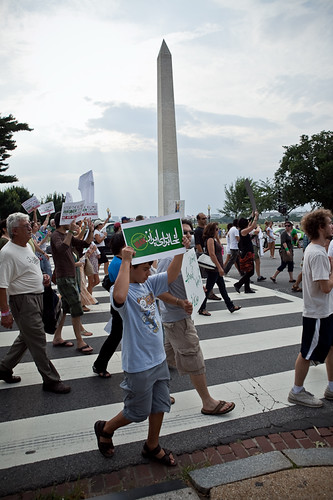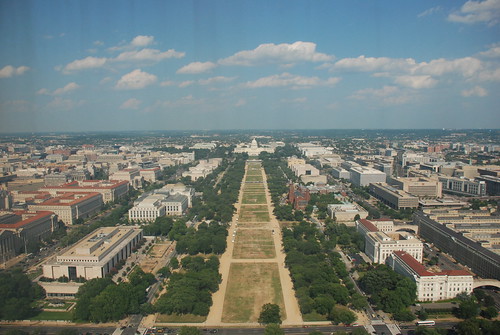
‘Iran Protest in DC’
courtesy of ‘spiggycat’
Welcome to another DC Mythbusting! This week, we’ll be discussing the National Mall and its place as the country’s ‘front yard’ for protesting and gathering. With such a wide open space, in view of both Congress and the President, clearly the National Mall was created to be a place of protest and free speech, right? And it has always served the role as the gathering place for Americans with something to say?
Not exactly. While the Mall was envisioned by Pierre L’Enfant as a “people’s park” along a grand avenue, it has been through many iterations before it became what it is today. The author of Grand Avenues states that the Mall was “a public statement of American destiny,” showing a horizon of possibilities from the Capitol (113). And while L’Enfant planned a grand vista along the axis (which turned out mostly perfectly) along with a singular equestrian statue, it wasn’t really built like that.

‘Bartholdi Fountain’
courtesy of ‘DC Public Library Commons’
Since it was so close to the center of power in the new city, the Mall took on a life of its own. During the Civil War it was used as a place to march troops and slaughter cattle. Andrew Jackson Downing’s 1851 plan ignored L’Enfant’s plan and turned the Mall into a natural wilderness retreat. By the beginning of the 20th century, the Mall was covered with trees, had a bunch of buildings all over it, and even had a railroad track running right through it. In 1901, Senator James McMillan decided that something had to be done, and thus the McMillan Commission was formed. It was the era of big plans and beautiful cities, and famed planners Daniel Burnham (who you may remember from such brilliant books as Devil in the White City) and Frederick Law Olmsted Jr (who was also involved in the 1893 World’s Columbian Exposition, though his father played the bigger role) were brought in to apply L’Enfant’s original plan back to the city. They envisioned the Mall as a broad public park, lined with important buildings and monuments, and created the McMillan Plan.
The McMillan Plan is the basis of what we know as the Mall today, but it still wasn’t a wide open space. The trees were eventually taken out and the railroad station was removed in 1909, but many buildings remained. The Main Navy and Munitions Buildings were built during World War I and weren’t demolished until 1970.

‘View from the Top’
courtesy of ‘JulieLG’
The 20th century was really when the Mall became what it is today. On Easter Sunday in 1939, the Daughters of the American Revolution barred singer Marian Anderson from entering Constitution Hall, so she moved her concert over to the steps of the Lincoln Memorial. This was a moment that changed the destiny of the Mall– it became a gathering place and a place of protest, and its new identity was solidified throughout the Civil Rights Movement. The Mall became an iconic gathering place particularly after Martin Luther King’s 1963 “I Have a Dream” speech. Since then, the Mall has been THE place to hold your protest.
It hasn’t all been smooth sailing, though. In 2003, Pepsi and the NFL held a giant Britney Spears concert on the Mall and paid $10 million to essentially buy the Mall for four days. The “NFL Kickoff Live From the National Mall Presented by Pepsi Vanilla” generated a lot of controversy, and events of that type that restrict access are no longer allowed.

‘Untitled’
courtesy of ‘Smithsonian Institution’
So there you have it: the National Mall hasn’t always been a place of protest, but that has been its primary role for the past seventy years. Before then it was everything from an overgrown forest to a cow pasture to a railroad depot. And even today it has many roles: gathering place to celebrate happy events, gathering place to remember sad events, home of festivals and fireworks, and tourist mecca.
Enjoy your myth-busting series.
Are you planning on doing one that discusses Washington as a place where everyone is from somewhere else?
Or is that true more so here than other places?
Seems like a lot of big cities have a transitory nature.
Thanks.
That’s a great idea, Jay! I hadn’t even thought of that, but it’s easy enough to figure out using Census information. I’ll get to work on it, and expect to see an answer back here for the next Mythbusting feature in two weeks!
There was at least a concept of marching on Washington as a form of protest prior to Marian Anderson’s concert, even if the protests weren’t held on the Mall. The Bonus Army of 1932 is the earliest one I know of; there may be earlier ones. I imagine the proliferation of television sets after World War II gave Mall protests a major boost. That way an organizer can have a demonstration surrounded by all of the Mall’s iconic imagery replayed in every American home.
I’m enjoying the DC mythbusting series. There is always something interesting.
Thanks Shannon. Look forward to it!
Thanks John. I think you’re definitely right about the influence of TV– protesting on the Mall is a way for any organizer to associate their cause with the iconic protests of history. The down side for them is that any gathering that isn’t at least a hundred thousand people looks like small potatoes.